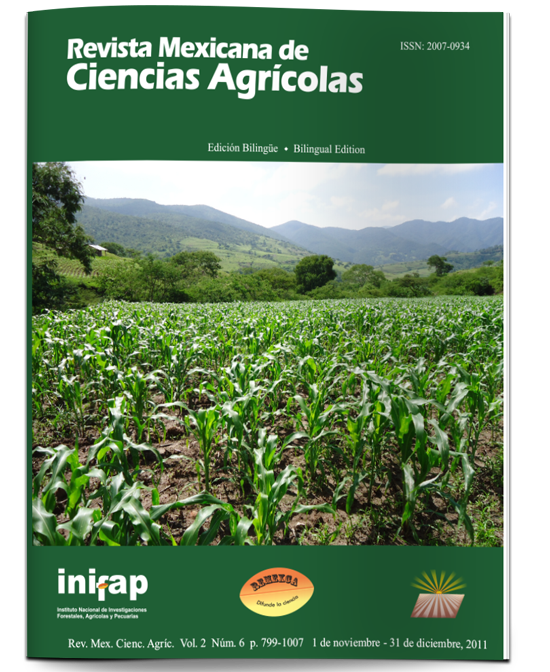BIOTIC-STRESS PROTECTION INDUCED BY CHITOSAN IN MAIZE (Zea mays L.) SEEDLINGS
DOI:
https://doi.org/10.29312/remexca.v2i6.1563Keywords:
Aspergillus f lavus, Fusarium moniliforme, Zea mays L., biopolymerAbstract
Maize (Zea mays L.) is an important crop in Mexico, which is often affected by the presence of pathogenic fungi. The objective of this paper was to determine the protective effect of chitosan in maize seedlings subjected to biotic stress. The experiment was conducted at the School of Advanced Studies Cuautitlán, UNAM, in 2008. In order to achieve the aim, after some quality tests, three groups of seeds were separately subjected to attacks by Aspergillus flavus and Fusarium moniliforme. A first group was considered as a positive control, another was coated with chitosan solution and, a final group was mechanically damaged before application of the biopolymer. For five weeks, the seedling growth was evaluated by measuring the total length, length of leaves, stems and, their thickness. There was no significant increase in the size of seedlings from seeds coated with chitosan when compared to the other groups, but, the absence of diseases in the seedlings treated with the biopolymer was quite evident. In the fifth week of growth, leaf structures of the seedlings were planted in agar PDA in order to determine the presence of stresful-fungi. It was found that, leaves from the seeds treated with chitosan developed no fungal burden, suggesting that, chitosan acts as an activator of defense mechanisms in maize seedlings, preventing infection by the pathogenic fungi.
Downloads
Downloads
Published
How to Cite
Issue
Section
License
The authors who publish in Revista Mexicana de Ciencias Agrícolas accept the following conditions:
In accordance with copyright laws, Revista Mexicana de Ciencias Agrícolas recognizes and respects the authors’ moral right and ownership of property rights which will be transferred to the journal for dissemination in open access. Invariably, all the authors have to sign a letter of transfer of property rights and of originality of the article to Instituto Nacional de Investigaciones Forestales, Agrícolas y Pecuarias (INIFAP) [National Institute of Forestry, Agricultural and Livestock Research]. The author(s) must pay a fee for the reception of articles before proceeding to editorial review.
All the texts published by Revista Mexicana de Ciencias Agrícolas —with no exception— are distributed under a Creative Commons License Attribution-NonCommercial 4.0 International (CC BY-NC 4.0), which allows third parties to use the publication as long as the work’s authorship and its first publication in this journal are mentioned.
The author(s) can enter into independent and additional contractual agreements for the nonexclusive distribution of the version of the article published in Revista Mexicana de Ciencias Agrícolas (for example include it into an institutional repository or publish it in a book) as long as it is clearly and explicitly indicated that the work was published for the first time in Revista Mexicana de Ciencias Agrícolas.
For all the above, the authors shall send the Letter-transfer of Property Rights for the first publication duly filled in and signed by the author(s). This form must be sent as a PDF file to: revista_atm@yahoo.com.mx; cienciasagricola@inifap.gob.mx; remexca2017@gmail.
This work is licensed under a Creative Commons Attribution-Noncommercial 4.0 International license.



